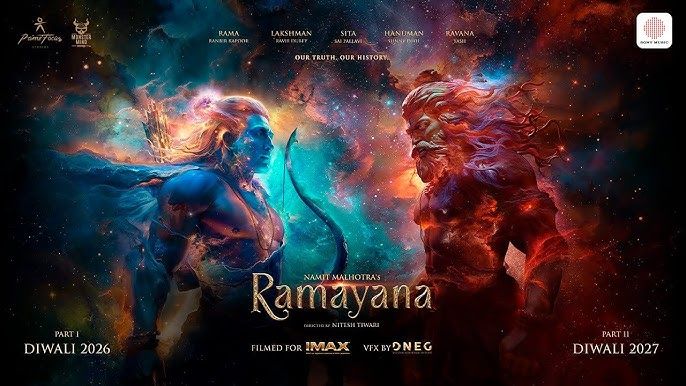Nitesh Tiwari’s Ramayan crosses ₹4000 crore budget, starring Ranbir Kapoor and Yash, aiming to become India’s biggest film ever.

The Indian film industry has never seen a project of this scale before. The upcoming epic Ramayan, directed by Nitesh Tiwari and produced by a powerful collaboration of top studios and financiers, has officially crossed a jaw-dropping ₹4000 crore budget, making it the most expensive film in Indian cinema history—and arguably one of the costliest productions globally.
This isn’t just a movie; it’s a cultural phenomenon in the making. With a vision to bring the legendary tale of Lord Ram, Sita, and Ravan to life with cinematic brilliance, the makers are pouring resources, talent, and technology into every frame. And the sheer numbers reflect the ambition: over ₹4000 crore means this project has already overtaken previous mega-films like RRR, Brahmastra, and Adipurush by several leagues.
What’s contributing to this massive budget?
Firstly, VFX and world-building. Unlike the rushed CGI seen in Adipurush, Ramayan is being crafted with global post-production teams, including those who have worked on The Lord of the Rings and Avatar franchises. Set construction alone is happening on a scale Bollywood has never imagined—replicas of Ayodhya, Lanka, forests, and battlefields are being built with obsessive historical detailing.
Second, casting and preparation. The star cast includes Ranbir Kapoor as Lord Ram, Sai Pallavi as Sita, and Yash as Ravan. Each actor is reportedly undergoing deep character research and physical transformation. Ranbir, for instance, has refused alcohol and meat for over a year to mentally prepare for the role, aligning himself spiritually with the essence of Ram. Yash, in contrast, is bringing his own style and gravity to the dark yet charismatic portrayal of Ravan.
According to reports, each lead actor is being paid a record-breaking fee, and their contracts include performance-based bonuses that could push their earnings even higher.
Third, international release strategy. Ramayan is being positioned not just as a pan-India film but as a global cinematic event. It will release in over 50 countries with voice dubs in more than 20 languages, and the promotional budget alone is estimated at ₹200 crore. Special screenings are already being planned in cities like Los Angeles, Dubai, London, and Tokyo.
Fourth, music and score. A.R. Rahman and Hans Zimmer have reportedly been approached for a possible collaborative soundtrack, fusing Indian classical elements with Hollywood-style orchestral intensity. The background score will be crucial, especially for battle sequences and emotional arcs like Sita’s abduction and Ram-Ravan’s final duel.
Let’s also not forget costumes and prosthetics. Designers from Europe and India are jointly working on over 20,000 costume pieces for extras, and advanced prosthetic technology is being used to depict vanar sena characters like Hanuman, Sugriva, and Bali with more realism and dignity than seen before.
Sources close to the project have confirmed that filming will continue till late 2026, with post-production stretching well into 2027. The makers are not in a hurry—they’re treating it as a legacy-defining film, much like how James Cameron treated Avatar or how Peter Jackson treated The Lord of the Rings trilogy.
There’s also growing speculation that Ramayan will be split into three parts, mirroring the structure of Ramayan Katha—Baal Kaand, Ayodhya Kaand, Aranya Kaand, Kishkindha Kaand, Sundar Kaand, and Lanka Kaand. The first part is expected to cover Lord Ram’s early years, marriage with Sita, and their exile. The second will deal with Sita’s abduction and Hanuman’s journey, while the third part will showcase the Lanka war and Ram’s return.
While audiences are excited, there’s also pressure. Adipurush—which was also based on Ramayan—faced massive backlash for poor writing and offensive portrayal of revered characters. But the team behind this Ramayan promises to be faithful to Valmiki’s and Tulsidas’s versions, while blending mythology with modern narrative techniques. Sanskrit scholars and religious consultants are working full-time on the screenplay to ensure authenticity.
The ₹4000 crore budget isn’t just a number. It represents an entire ecosystem of trust—investors, actors, filmmakers, and the audience—willing to bet on mythology done right. If this film succeeds, it could redefine what Indian cinema stands for on the global stage. If it fails, it would be one of the most expensive missteps in film history.
But going by the current buzz, the project is being handled with far more caution, devotion, and seriousness than earlier attempts. With top talent both in front and behind the camera, Ramayan might just become a benchmark in mythological cinema—both in India and around the world.

